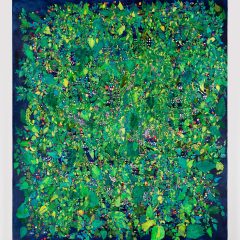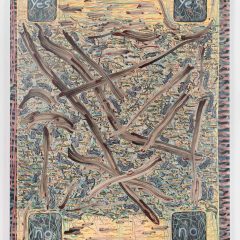Google “toxic masculinity” and you’ll receive 372,000 hits. The current #MeToo moment and movement has revealed an epidemic of men behaving very badly—violently, abusively—towards women. Many understand the misogyny spotlighted by #MeToo as part and parcel of a sickness that’s long run rampant throughout our society and now has the U.S. running off its rails. Primary evidence of this testosterone-fueled wreckage-in-progress: the id-man occupying the White House, his overwhelmingly male enablers in Congress, and the disproportionately andric mass of his status-threatened supporters.
A tale of two Gen X-ers
Tristin Lowe and Cary Leibowitz are mid-career artists known for creating work that surprises and provokes but, if there is potential harm, the likely victims are the artists themselves. Leibowitz and Lowe share gender (male) and race (white) but not sexuality: Lowe is straight, Leibowitz is gay. This orientation-in-love is, of course, relevant when thinking about their art and what it says about masculinity. However, it may be secondary to something they share by dint of birth. Leibowitz was born in 1963, Lowe in 1966. Their cohort ushered in Generation X, the largely overlooked demographic squeezed between the attention-commanding Baby Boomers and Millennials. Per the truthful kernels contained in clichéd, over-generalized pop-sociological labels, Gen Xers were (are?) alienated, irony-saturated slackers with diminished expectations. Gen X was the first in American history predicted to do less well than its parents, and was seen as responding to this downward-mobility with a shrug of the shoulders.
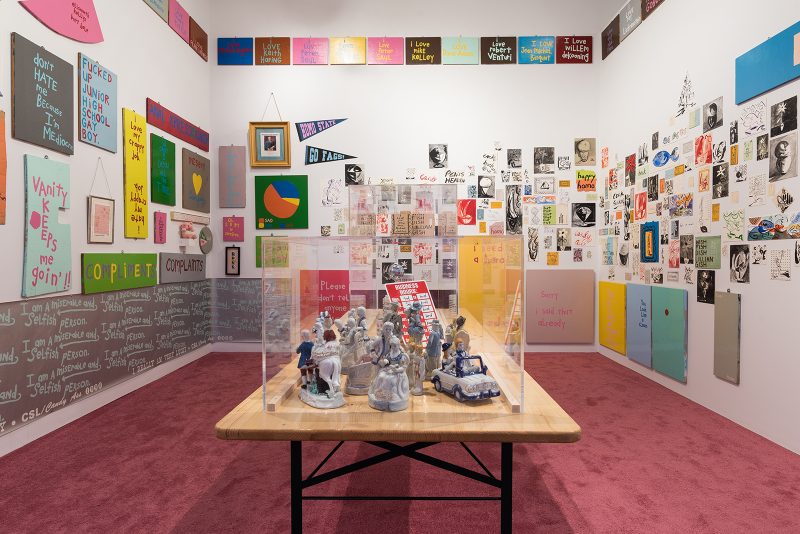
The characteristically schlubby and self- and other-deprecating sensibility of Gen Xers represented the zeitgeist for a distinct era in New York-centric American art: the early-to-mid-1990s. Mike Kelley, Sean Landers, Pruitt & Early, Jim Shaw—and, very much, Leibowitz—were the recognized pathetic, abject, loser, mock-heroic-but-still-heroic “bad boys” of the day.
At around the same time in Philadelphia, Tristin Lowe and artists connected with artist-collectives such as the seminal Vox Populi (founded in 1988) established a punk-infused, do-it-yourself, often ingenious but always unglamorous aesthetic that quickly came to occupy the forefront of the contemporary cutting-edge in the city’s then-leading gallery district, Old City.
The tragicomic dust-up in Manayunk
Through September 19th in Philadelphia’s Manayunk section, Lowe’s just-larger-than-life sculpture Maelstrom Analytica is taking toxic and pathetic masculinity to the street—the corner of Main and Rector streets, specifically. Presented by Mount Airy Contemporary at Intuitive Art Space (MAC@IAS), Lowe’s Maelstrom is a gargantuan (its diameter is nine-to-ten feet in all directions) ball of unrest perched slightly above street-level in a store-front space with floor-to-ceiling windows facing Main and Rector. It appears ready to break loose from its gallery moorings and roll amok like a comic yet violent tumbleweed upending the easy pleasures of Manayunk’s shoppers and diners.
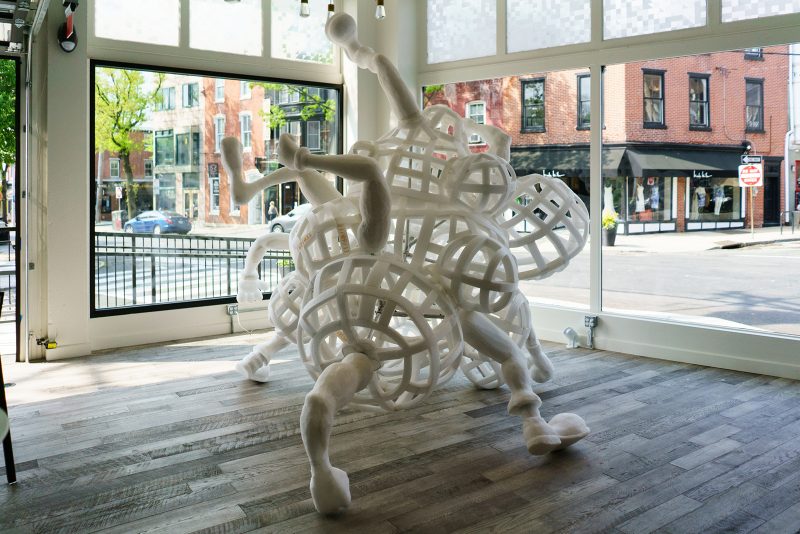
The description of Lowe’s work and the particulars of his Maelstrom on MAC’s website is exceedingly quotable: Lowe’s creative “practice delves into the crude and rude, absurd and abject—pushing low-brow, low-tech methods toward unexpected ends…Lowe’s wry re-imaginings lead the viewer down a path littered with chaos, comedy, and failure.” In photographs, Maelstrom Analytica looks decidedly high-tech: it appears gleamingly white and of such complexity, scale, and seamless perfection that computer-aided design is assumed. In person, however, its low-tech character is clear. Lowe carved his Maelstrom in Styrofoam-like Ethafoam. Its monumentally globular mass is held together by a metal support-structure only partly concealed behind its looping, concentric lines and projecting limbs.
Anyone who has seen a Looney Tunes cartoon, or perhaps any sampling of comic illustration from the mid-20th century onward, will “get” Lowe’s reference and inspiration: a brawl depicted as a dust-cloud from which the combatants’ clenched-fists hands and kicking feet emerge up, down, and sideways. Fisticuffs a la Looney-Tunes are as laughable and harmless as their endearing characters/antagonists — they pack a graphic punch but the actions illustrated are understood to be ridiculous; “We know from prior examples in popular culture that the outcome of any such ‘dust-up’ will be humiliating at the least, and possibly absurd” wrote co-directors Andrea Wohl Keefe and Colin Keefe on MAC’s site.
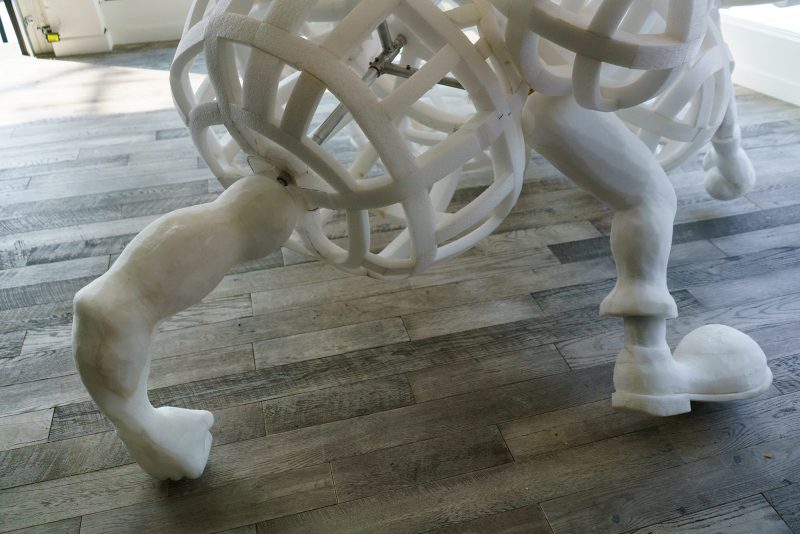
Maelstrom Analytica conjures Cambridge Analytica, the perhaps-criminal British political-data firm hired by the Trump campaign and implicated in Russia’s social-media hacking of the 2016 election. Like the cartoons of our youth, we’ve viewed this development and the acts and tweets of the Trump presidency—along with #MeToo revelations, school shootings, police brutality and Black Lives Matter protest, and furied reporting of news both fake and all too real—through the screens of our televisions and, now, those of our phones and PCs. With Maelstrom Analytica, Lowe converts a cartoon trope into a three-dimensional tragicomic metaphor for the lived reality of our Bizarro World of (largely) masculine toxicity that, while absurd, is no laughing matter.
Passive/Agressive
“Respect for the United States Constitution Is a Turn-On” proclaim red-white-and-blue coffee-mugs (two for $17.76!) and off-colorful latex-on-wood text-paintings featured in recent exhibitions by Cary Leibowitz at Philadelphia’s Institute of Contemporary Art, Fleisher/Ollman Gallery* and his representing-gallery, New York’s Invisible-Exports. And so the Ur-Gen-X-slacker-loser Leibowitz makes the political personal and highlights the (sex)-appeal of civic knowledge and duty. Leibowitz’s text-based art is best-known for unrelenting, self-lacerating self-deprecation that, purposely and pointedly, Leibowitz pushes into the realm of self-absorbed narcissism that is as damaged and damaging in its caricature of whining, effete passivity as the macho free-for-all of overt aggression. But social awareness and concern have always been central to Leibowitz’s work — they are the core of his sensibility. A bravely honest and arresting artistic statement from the earliest years of Leibowitz’s career in words-on-objects announced “There are 2 things I will have 2 watch 4 the rest of my life — my weight and my racism.”
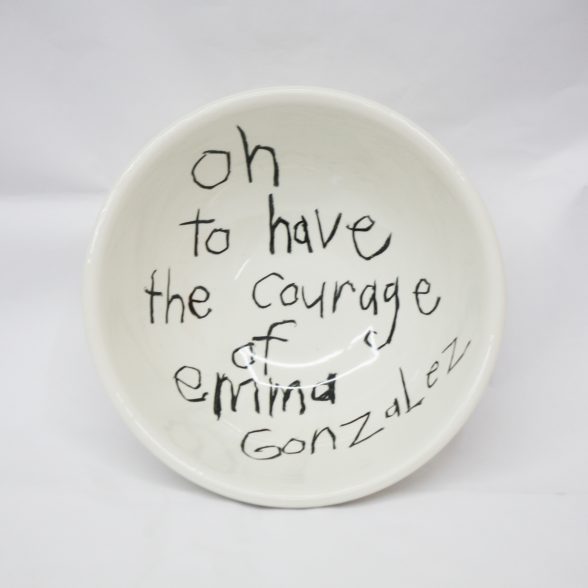
A maker of large-edition multiples and serialized paintings, Leibowitz’s oeuvre has been a tireless marathon and ceaseless torrent of satire directed at homophobia, anti-Semitism, art-world elitism, racism, and sexism. But, first and foremost, Leibowitz satirizes himself as a deeply flawed everyman—albeit the boy/man-next-door who happens to be gay, Jewish, anxious, depressed, and suffering serious body-image issues. At Fleisher/Ollman, a painting equivocates “I’m sorry I thought you said pull the trigger,” dramatically subverting Leibowitz’s witless sad-sack gay-male goofball persona into a perpetrator of mayhem, maybe murder. At Invisible-Exports, Leibowitz sighed “Oh to have the courage of Emma Gonzalez” in his idiosyncratic black scrawl on a generic white ceramic vessel. Still very much in the trenches and fighting his own good fight, Leibowitz salutes a rising generation unbound by gender and fiercely committed to curing us and the U.S.
Indeed. And yes, please.
*Disclosure: I have enjoyed personal and professional connections with Cary Leibowitz and Tristin Lowe for many years, collected their work modestly, and served as guest-curator for Leibowitz’s Happy Days Good Times/Vicey Versy at Fleisher/Ollman.
Matthew F. (Matt) Singer, Ph.D., is a writer, curator, and educator. He worked for 23 years as a writer for the Philadelphia Museum of Art, 15 years (pro bono) as curator of the Philadelphia Museum of Jewish Art, and has taught at Penn State (Abington and Harrisburg campuses) and Tyler School of Art.




